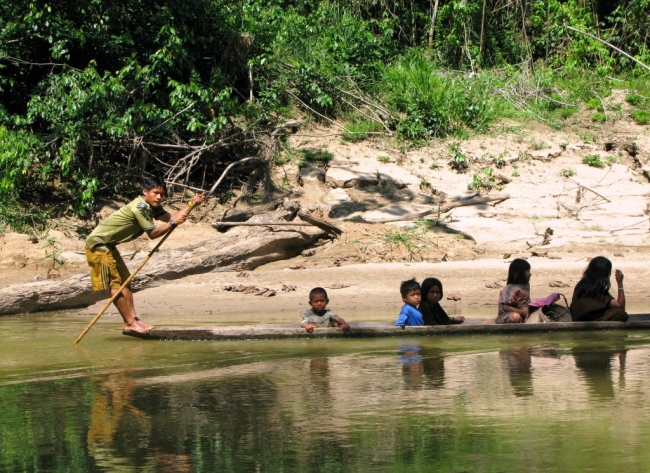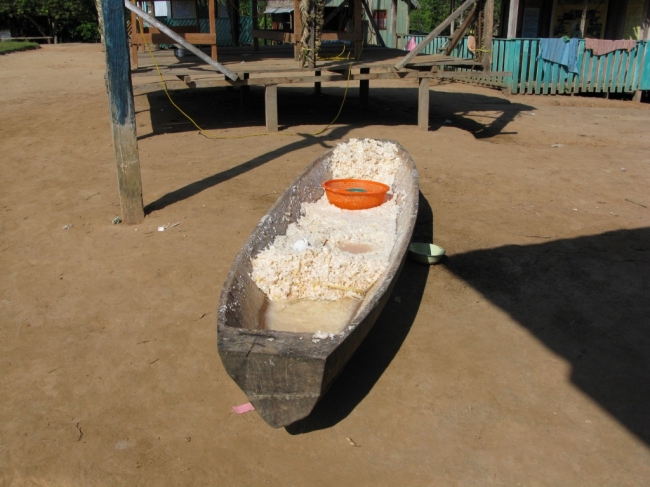This trip of ours to Brasil was brought to life by two men and their visions of what the Amazon Forest means to its indigenous peoples & what it could mean to the wider world, if experienced responsibly. Benki Piyako, respected member of the Ashaninka people, is at 35 years old a possible future of the indigenous peoples interactions with the modern states of South America, he is articulate, educated & has a sense of how his cultural identity can play a positive role. Meanwhile Tony Annis a long time Globetrotter member and established photographer, was raised in Brasil during his school years and has over the years has grown more passionate about what makes Brasil tick and how it should be enjoyed.

Picture courtesy of The Ant: our first sighting of Marechal Thaumaturgo, with Rio Amonia on the left !
We six tourists first met up with Benki & a number of the Ashaninka at Marechal Thaumaturgo’s airstrip (in Brasil’s western most state – Acre), perfectly timed for a step into the unknown. On departure day, four flat, metal hulled motor boats were loaded with our packs, food, umbrellas & guns and iced drinks and after what became the regularly fluid morning chats about what might happen for the day, the word was given and we’re off ! Turn right after the town and up Rio Amonia we went !!
Those umbrellas were vital in this supposed dry season continuous rain for the first few hours could have easily sapped our keenness before we reached our first stop at Apiwxta (pronounced aputure). Bizarrely it was water that probably got us into enjoying this adventure‚…the boat with John, Trish & I in hit an unseen & very underwater log and our world was instantly turned upside down. Despite the best efforts of Chico our driver, all of our goods were dunked into the brown, muddy & very fast flowing river frantically we grabbed the most precious items – our cameras – and let the following boats rescue everything, including ourselves. Tony was most disappointed that he had not been around to get any pictures of the upset. Adaptable is a byword for getting the most out of their surroundings – everything was stripped down, dried and within an hour or so we were on our way again. I had images of us being marooned over night, but no the Ashaninka soon had us underway.
Apiwxta is so, so different from most places I have ever experienced before. It epitomises the symbiotic relationship the Ashaninka have with the forests buildings, food, clothes and even socialising are derived from materials found within their surroundings. Only functional, hardwearing objects such as machetes, outboard motors and cooking ports come from our outside world. These people only take what they need for their communities at this point and further up river there is little evidence of the destructive practices of forestry that have many up in arms. In fact the rapidly rising & sinking levels of the river have wreaked more damage, as its course varies with the seasonal downpours. We evening’d over a meal of freshly caught fish, manioc, paste & cold, cold beers. This, including the beer, became our staple diet for most of the whole trip along the river though it was sometimes varied by what ever could be hunted by bows & arrows or very ancient rifles sometimes even Benki failed to bring back anything extra ! We also got to experience herbal medicines, as I’d bounced Francesca off a wooden balcony and she had the resulting bloody wound patched up with just honey & plant extracts despite having to wear a large bandage, just in case, she didn’t swear at me once and was most intrigued on what had been applied to her head.
 Picture courtesy of The Ant: boating the traditional way, up the Rio Amônia past Apiwxta
Picture courtesy of The Ant: boating the traditional way, up the Rio Amônia past Apiwxta
Days two & three had us heading further up towards the Peruvian border each day was spent bouncing along, dodging fallen trees and attempting to avoid numb bums & sun burn. Each night we slept on a river beach, underneath palm tree lean shelters with our hammocks swung into place & the much needed mosquito nets added ! Swimming in the muddied swirls of the Amonia became the best way to exfoliate the day away. But those damned flies & mosquitoes nearly rubbished all this serene pleasure for us, we had to use industrial quantities of deet, soothing creams & sun protection in an unequal battle to fend off bite after bite even back in Rio de Janeiro week’s later people still remarked on my pock marked legs !
The fourth day found us crossing the border into Peru and up into the village of Sawawo to support our Ashaninka in a football tournament organised to commemorate the country’s independence. Through the heat & mixed of indigenous/state communities we cheered on Benki & his rock of a player brother Bebito, as they defeated all comers to seal the title. The evening’s celebrations descended into a cacophony of Peruvian disco, shuffling dancing and a boatful of fermented manioc & sweet potatoes and Don in particular paid the price for over indulging as we began our return in a haze the next day.
 Picture courtesy of The Ant: Tome boat at SawawoÂ…the morning after!!!
Picture courtesy of The Ant: Tome boat at SawawoÂ…the morning after!!!Our final leg was particularly poignant, I sat up front on the lead boat on the last day, getting splashed and dodging so many hanging branches, as we left behind the more traditional Ashaninka way of life and navigated our way down past the small homesteads and onto Marechal’s blurred junction of Rios Amonia & Juru. A sense of departure & change pervaded my thoughts, we were heading eastwards towards Brasil and ultimately home, the joy of sharing our unknown was almost over all too quickly.
Want to know more about the Ashaninka and their lives ?
- their cosmology and more –
- about their community at Apiwxta –
- BenkiÂ’s role in environmental & indigenous issues for the Ashaninka and the Brasilians – http://www.ashoka.org/node/3954
